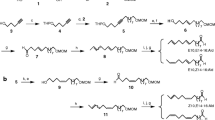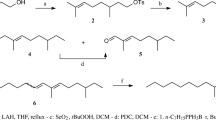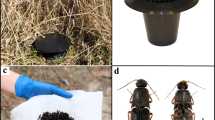Abstract
The sex pheromone of Mnesampela privata, an endemic pest of Eucalyptus plantations in Australia, was previously identified as a single bioactive compound, (3Z,6Z,9Z)-3,6,9-nonadecatriene (C19 triene). Initial field testing of lures containing 1 mg, 5 mg or 10 mg of C19 triene (>98% purity) caught no or very few male M. privata. (3Z,6Z,9Z)-3,6,9-Henicosatriene (C21 triene) was identified as an additional minor pheromone component in abdominal tip extracts of M. privata females from Tasmania. Levels of both compounds extracted from individual females varied greatly, but the ratio was relatively constant at 33:1 C19:C21 trienes. Electroantennograms (EAG) of synthetic C21 triene with male M. privata gave positive but consistently lower responses than elicited by the C19 triene. Field tests showed that the addition of 1–6% C21 triene to 1 mg C19 triene significantly increased trap catch and the detection of M. privata in plantations. Traps baited with a 16:1 ratio caught significantly more moths than those baited with a ratio approximating that of females.






Similar content being viewed by others
References
ALLISON J. D. and CARDÉ, R.T. 2006. Heritable variation in the sex pheromone of the almond moth, Cadra cautella. J. Chem. Ecol. 32:621–641.
Bashford, R. 1993. Insect pest problems of eucalypt plantations in Australia. 4. Tasmania. Aust. For. 56:375–377.
CARDÉ, R.T. and BAKER, T.C. 1984. Sexual communication with pheromones, pp. 355–383, in W.J. Bell and R.T. Cardé (eds.). Chemical ecology of insects. Chapman and Hall, London.
DAVIES, N.W., MEREDITH, G., MOLESWORTH, P.P., and SMITH, J.A. 2007. Use of anti-oxidant BHT in situ for the synthesis of readily oxidised compounds: Application to the synthesis of the moth pheromone (Z,Z,Z)-nonadecanonadeca-3,6,9-triene. Aust. J. Chem. 60: 848–849.
El-Sayed, A.M. 2008. The pherobase: database of insect pheromones and semiochemicals. <http://www.pherobase.com>. ©2003–2008 The pherobase—extensive database of insect pheromones and semiochemicals.
Heath, R.R., Landolt, P.J., Leppla, N.C., and Dueben, B.D. 1988. Identification of a male-produced pheromone of Anticarsia gemmatalis (Hübner) (Lepidoptera: Noctuidae) attractive to conspecific males. J. Chem. Ecol. 14:1121–1130.
Mcquillan, P. B. 1996. The Tasmanian geometrid moths associated with the genus Amelora auctorum (Lepidoptera: Geometridae: Ennominae). Invertebr. Taxon. 10:433–456.
Millar, J.G. 2000. Polyene hydrocarbons and epoxides: A second major class of lepidopteran sex attractant pheromones. Annu. Rev. Entomol. 45:575–604.
MILLAR, J.G., GIBLIN, M., BARTON, D., and UNDERHILL, E.W. 1990. 3Z,6Z,9Z-nonadecatriene and enantiomers of 3Z,9Z-cis-6,7-epoxy-nonadecadiene as sex attractants for two geometrid and one noctuid moth species. J. Chem. Ecol. 16:2153–2166.
Millar, J.G., Giblin, M., Barton, D., Wong, J.W., and Underhill, E.W. 1991. Sex attractants and sex pheromone components of noctuid moths Euclidea cuspidea, Caenurgina distincta, and geometrid moth Eupithecia annulata. J. Chem. Ecol. 17:2095–2111.
Millar, J.G., Giblin, M., Barton, D., and Underhill, E.W. 1992. Sex pheromone components of the geometrid moths Lobophora nivigerata and Epirrhoe sperryi. J. Chem. Ecol. 18:1057–1068.
Östrand, F., Elek, J.A., and Steinbauer, M.J. 2007. Monitoring autumn gum moth (Mnesampela privata): relationships between pheromone and light trap catches and oviposition in eucalypt plantations. Aust. For. 70:185–191.
Rapley, L.P., Allen, G.R., Potts, B.M., and Davies, N.W. 2007. Constitutive or induced defences—how does Eucalyptus globulus defend itself from larval feeding? Chemoecology. 17:235–243.
RAPLEY, L.P., POTTS, B. M., BATTAGLIA, M. B., PATEL V.S., and ALLEN, G. R. 2009. Long-term realised and projected growth impacts caused by autumn gum moth defoliation of 2-year-old Eucalyptus nitens plantation trees in Tasmania, Australia. For. Ecol & Manag. 258:1896–1903.
Szöcs, G., Tóth, M., Francke, W., Schmidt, F., Philipp, P., König, W.A., Mori, K., Hansson, B.S., and Löfstedt, C. 1993. Species discrimination in five species of winter-flying geometrids (Lepidoptera) based on chirality of semiochemicals and flight season. J. Chem.Ecol. 19:2721–2735.
Szöcs, G., Tóth, M., Karpati, Z., Zhu, J.W., Löfstedt, C., Plass, E., and Francke, W. 2004. Identification of polyenic hydrocarbons from the northern winter moth, Operophtera fagata, and development of a species specific lure for pheromone traps. Chemoecology. 14:53–58.
Steinbauer, M.J., McQuillan, P.B., and Young, C.J. 2001. Life history and behavioural traits of Mnesampela privata that exacerbate population responses to eucalypt plantations: comparisons with Australian and outbreak species of forest geometrid from the northern-hemisphere. Austr. Ecol. 26:525–534.
Steinbauer, M.J., Östrand, F., Bellas, T.E., Nilsson, A., Andersson, F., Hedenström, E., Lacey, M.J., and Schiestl, F.P. 2004. Identification, synthesis and activity of sex pheromone gland components of the autumn gum moth (Lepidoptera: Geometridae), a defoliator of Eucalyptus. Chemoecology 14:217–223.
STRONG, W.B., MILLAR, J. G., GRANT, G.G., MOREIRA, J.A., CHONG, J.M., and RUDOLPH, C. 2008. Optimization of pheromone lure and trap design for monitoring the fir coneworm, Dioryctria abietivorella. Entomol. Exp. Appl. 126: 67–77.
Wang, S. and Zhang, A. 2007. Facile and efficient syntheses of (3Z,6Z,9Z)-3,6,9-nonadecatriene and homologues: Pheromone and attractant components of Lepidoptera. J. Agric. Food Chem. 55:6929–6932.
Wong, J.W., Underhill, E.W., MacKenzie, S.L., and Chisholm, M.D. 1985. Sex attractants for geometrid and noctuid moths. Field trapping and electroantennographic responses to their hydrocarbons and monoepoxydiene derivatives. J. Chem. Ecol. 11:727–756.
Acknowledgements
This research was funded by the Australian Research Council Linkage Projects grant LP0455303. We thank Gunns Ltd, Forestry Tasmania, Timbercorp, WAPRES, and FFIC for funding and assistance. PPM is thankful to the University of Tasmania and the Thomas Crawford Foundation for a postgraduate scholarship. Thanks also to: Dr. Peter McQuillan (University of Tasmania) and Dr. Cathy Young (Tasmanian Museum and Art Gallery) for identifying geometrids, Dr. Mamoru Matsuki (IPMG, Albany) for conducting trapping trials in Western Australia and supplying moths for analysis, Mr. Ben Bradshaw (Timbercorp, Penola) for conducting trapping trials in Victoria and South Australia, and Dr. Martin Steinbauer for help with comments on the manuscript and the formulation of the original grant. We are also grateful for the financial support (for AN, FA, and EH) from the European Regional Development Fund and Länsstyrelsen i Västernorrlands län.
Author information
Authors and Affiliations
Corresponding author
Rights and permissions
About this article
Cite this article
Walker, P.W., Allen, G.R., Davies, N.W. et al. Identification, Synthesis and Field Testing of (3Z,6Z,9Z)-3,6,9-Henicosatriene, a Second Bioactive Component of the Sex Pheromone of the Autumn Gum Moth, Mnesampela privata . J Chem Ecol 35, 1411–1422 (2009). https://doi.org/10.1007/s10886-009-9717-2
Received:
Revised:
Accepted:
Published:
Issue Date:
DOI: https://doi.org/10.1007/s10886-009-9717-2




